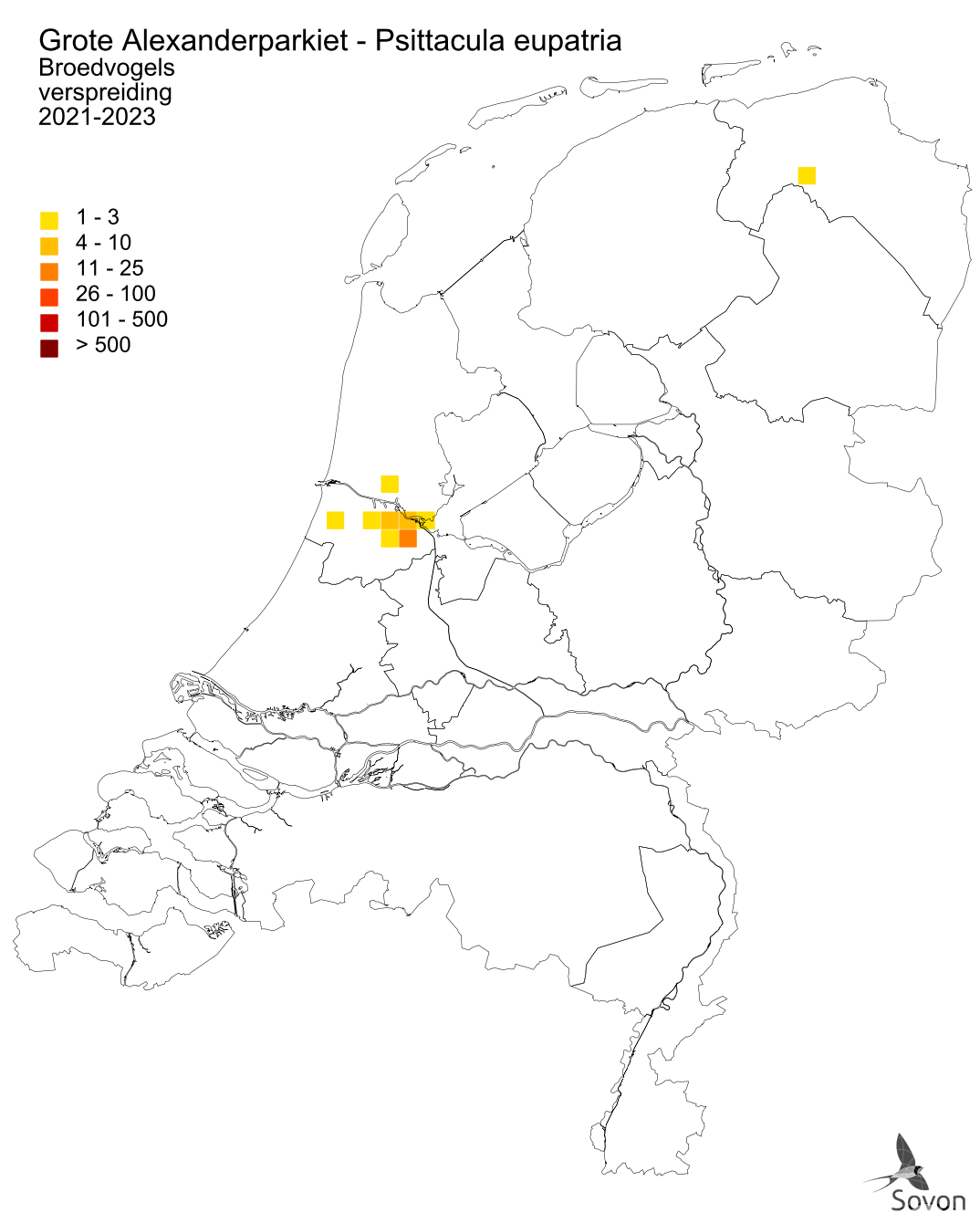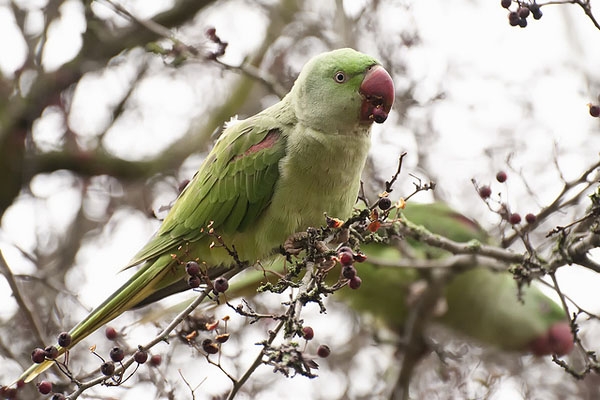Verspreiding en trends
Verspreiding

Deze kaart is gebaseerd op landelijke tellingen van kolonievogels en zeldzame broedvogels (Meetnet Broedvogels). Per atlasblok van 5x5 km is het aantal broedparen gegeven.

Deze kaart is gebaseerd op de Vogelatlas van Nederland (Sovon 2018). Per atlasblok van 5x5 km is er een schatting van het aantal individuen gegeven.
Aantalsontwikkeling
Onvoldoende gegevens beschikbaar voor trendanalyse.
Broedsucces en overleving
Onvoldoende gegevens beschikbaar voor trendanalyse.
Seizoensvoorkomen
Onvoldoende gegevens beschikbaar voor trendanalyse.
Beschrijving voorkomen
Voorkomen
Exoot. Herkomstgebied Zuidoost-Azië. Grote Alexanderparkieten worden vanaf de eeuwwisseling in toenemende mate gezien, met name in Amsterdam. Daarbuiten gaat het om kleine aantallen. Bij tellingen op gemeenschappelijke slaapplaatsen met Halsbandparkieten gaat het inmiddels om bijna duizend exemplaren. Het eerste zekere broedgeval komt uit 2006 in Amsterdam, maar vermoedelijke broedde de soort hier al eerder. De populatie groeit nog steeds. Tegenwoordig gaat het om tientallen broedparen in Nederland.
Vogelrichtlijn
Staat van instandhouding
Voor deze soort is geen Staat van Instandhouding van toepassing. De Grote Alexanderparkiet is een exoot en valt daarmee buiten artikel 1 van de Vogelrichtlijn, dat betrekking heeft op alle natuurlijk in het wild levende vogelsoorten op het Europese grondgebied van de EU-lidstaten. De Grote Alexanderparkiet is daarmee ook niet beschermd op grond van de Wet natuurbescherming.
Aangewezen gebieden
Er zijn geen gebieden aangewezen voor deze soort.
Telrichtlijnen
Broedvogels
Methode
Territoriumkartering
Tijd van het jaar
Begin februari t/m eind juni
Tijd van de dag
Gehele dag
Datumgrenzen, normbezoeken en fusieafstand
| geldige waarnemingen | normbezoeken | minimaal vereist | fusie- | |||||||||
| adult | paar | terr | nest | migrant | 1 | 2 | 3 | seizoen | datumg | datumgrens | afstand | |
| . | X | X | X | 2 | 25-1 t/m 30-6 | 500 | ||||||
Aanwijzingen
Beste periode is vóór het uitlopen van de bomen. Paren bij geschikte nestplaats [broedcode 3] (natuurlijke holen, meestal van spechten in oude loofbomen – veelal platanen; soms in grote nestkasten), met speciale aandacht voor balts [brc 2] (incl. baltsvoedering en copulatie, vaak vlakbij nesthol), nestbouw [brc 9] (ook vogel met houtmolm op verenkleed bij geschikt nesthol!) en nestbezoek [brc 13] (grotere jongen worden in nestopening gevoerd).
LET OP: nestelt soms samen met Halsbandparkiet en vormt hier soms mengparen mee.
Documentatie
Broedgevallen graag goed documenteren, met gegevens over samenstelling paar (puur of mengpaar met Halsbandparkiet), nestplaats en broedgedrag.
Broedbiologie
Weinig bekend uit Nederland. In Duitsland en Engeland broedend in losvaste kolonies (soms verschillende paren per boom). Eileg half maart tot eind april. Eén broedsel per jaar, meestal 2-4 eieren, broedduur 19-21 dagen, nestjongenperiode rond 53 dagen.
Slaapplaatstelling
Tijd van het jaar
December-januari.
Tijd van de dag
Avond: van 1 uur voor zonsondergang tot half uur erna.
Aanwijzingen
- Slaapplaats lokaliseren door volgen van slaaptrek in avond (richting belangrijk!) of evt. gericht bezoeken van geschikte locaties rond zonsondergang.
- Oppassen met voorverzamelplaatsen (vogels verkassen nog).
- Zoek telpunt met goed uitzicht op aan/afvliegende vogels.
- Grote slaapplaatsen met meerdere mensen tellen.
- Vogels arriveren bij helder weer gemiddeld later dan bij donker weer.
- Bij aanvang van telling aanwezige vogels noteren, vervolgens aan- en/of afvliegende vogels noteren.
Bijzonderheden
- Slaapplaats doorgaans in bomen.
- Minstens een half uur voor zonsondergang beginnen en volgehouden zolang de lichtomstandigheden dat toelaten en er gedurende minstens vijf minuten geen invliegende parkieten meer worden waargenomen.
- Omdat meerdere slaapplaatsen binnen een gebied aanwezig kunnen zijn, zijn simultane slaapplaatstellingen noodzakelijk om aantallen vast te stellen.
- Vogels maken geregeld gebruik van voorverzamelplaatsen en vliegen als groep naar de definitieve slaapplaats.
- Verschijnt ’s avonds vaak eerder op de slaapplaats dan Halsbandparkiet.
- Afvliegen in ochtend rond zonsopkomst.
- Meestal samen met Halsbandparkieten. Let op rauwe roep en rustiger vlieggedrag van Grote Alexander.
